|
|
|
|
|
A Review of Wind Energy Integration in Masdar City’s Smart Urban Development
Parool Chauhan 1![]() , Suman Pandey 2
, Suman Pandey 2![]()
1 Gujarat
Law Society, Institute of Design, India
2 Assistant
Professor, Gujarat Law Society University, Ahmedabad, India
|
|
ABSTRACT |
||
|
This research investigates the
incorporation of wind energy into the sustainable urban framework of Masdar
City, demonstrating the significant role that wind energy plays in the
development of an urban ecosystem that is efficient in terms of energy consumption.
As a pioneering example of environmentally responsible urban construction,
Masdar City integrates a wide range of renewable energy sources, with wind
energy making a substantial contribution to the city's efforts to achieve its
sustainability goals. In this study, the technical and operational elements
of Masdar City's wind systems are investigated. The evaluation addresses both
the successes that were achieved and the difficulties that were faced
throughout the implementation process. The usage of wind energy, which is a
significant component of the city's plan for renewable energy, is a clear
indication of the city's dedication to lowering carbon emissions and
decreasing its dependency on fossil fuels.
In addition to this, the report highlights the creative design and
planning strategies that enable Masdar City to incorporate wind energy into
its urban form in a seamless manner. Insights gained from Masdar's expertise
provide significant recommendations for metropolitan regions all over the
world, particularly for growing smart cities that are eager to implement
solutions that utilize renewable energy sources. In particular, these lessons
are applicable to GIFT City, which is located in Gandhinagar, India, and is
working toward a more sustainable urban infrastructure in the future. It is
possible for GIFT City to take the lead in sustainable development in India
by adopting the strategy that Masdar City has taken. This would involve
employing wind energy to improve energy security and environmental
resilience. The findings of this study highlight the potential of wind energy
to contribute to the advancement of urban sustainability. It also provides a
model for the integration of alternative energy systems in analogous
metropolitan situations, particularly in India. |
|||
|
Received 09 May 2025 Accepted 27 June 2025 Published 30 June 2025 Corresponding Author Parool Chauhan, parool19@gmail.com DOI 10.29121/ShodhShreejan.v2.i1.2025.27 Funding: This research
received no specific grant from any funding agency in the public, commercial,
or not-for-profit sectors. Copyright: © 2025 The
Author(s). This work is licensed under a Creative Commons
Attribution 4.0 International License. With the
license CC-BY, authors retain the copyright, allowing anyone to download,
reuse, re-print, modify, distribute, and/or copy their contribution. The work
must be properly attributed to its author.
|
|||
|
Keywords: Wind Energy,
Sustainable Urban Framework, Masdar City, Renewable Energy, Gift City, Urban
Sustainability |
|||
1. INTRODUCTION
The global shift to sustainable energy has established urban wind energy as a prominent element of renewable initiatives, as cities seek to use renewable resources in highly populated regions Smith, J. (2022). Urban wind energy: Integrating Renewables into the Urban Fabric. Renewable Energy Journal.
United Nations. (2021). World urbanization prospects. United Nations Department of Economic and Social Affairs.). Urban populations are rapidly increasing, leading cities worldwide to seek low-carbon and energy-efficient solutions Figure 1 United Nations. (2021). Masdar City, located in Abu Dhabi, exemplifies sustainable urban development by using renewable energy to attain net-zero emissions and diminish dependence on non-renewable resources Masdar. (2023). Masdar City: Sustainable Development in Action. Masdar Official Website..
Figure 1

|
Figure 1 The Rising Population Directly Increases Energy Demand, Leading to a Higher Carbon Footprint. To Mitigate this Environmental Impact, we Must Harness Sustainable Energy Sources to their Full Potential. By Transitioning to Renewable Energy Solutions, we Can Reduce Emissions and Create a more Eco-Friendly, Sustainable Future for all |
Masdar City, an urban development characterized by carbon neutrality and zero waste, exemplifies the Masdar initiative's commitment to enhancing the deployment of existing renewable technologies and their integration into efficient systems, positioning itself as a pioneer in next-generation energy and sustainability. Nader, 2009. The city's ambitious objective is to employ energy within a socially, economically, and environmentally sustainable framework while preserving contemporary lifestyles. D'Eramo, 2021 To maintain attention on carbon efficiency aims, Abu Dhabi's Urban Planning Council developed the Pearl Rating System to evaluate buildings for compliance with design and structural standards. Sankaran and Chopra (2020)
The city's sustainable strategy include not only the integration of renewable energy but also water recycling, smart technical designs, and the blending of traditional Arab architectural styles to reduce energy and material use. Nevertheless, a decade post-construction, Masdar City has not attained its net-zero carbon emissions objective, achieving just 50% by 2016. D'Eramo (2021)
Masdar City encounters several problems in attaining its sustainability objectives, encompassing technological, social, and financial impediments. Nevertheless, the initiative functions as a significant case study for comprehending the convergence of neoliberalism and environmentalism in influencing urban development and the prospects for renewable energy incorporation in sustainable communities.
2. Research Scope
This paper analyses Masdar City's use of wind energy into its intelligent urban architecture, emphasizing systems, planning, and design solutions that promote sustainable energy utilization. This analysis juxtaposes these methodologies with GIFT City in Gandhinagar, India, examining the adaptability of Masdar’s wind energy technologies to the Indian environment for efficient energy integration and intelligent urban development. The research provides significant insights into sustainable urban energy systems, enhancing global discussions on urban sustainability and offering flexible options for various urban contexts globally. The results seek to guide policy and design strategies for energy-efficient urban development worldwide.
2.1. Research Objectives
1) Study Focus: Analyses the integration of wind energy in Masdar City and GIFT City to inform Indian smart cities on sustainable urban development in accordance with national climate objectives.
2) Masdar City Overview: An international exemplar of sustainable design that utilizes renewable energy, especially wind, to diminish energy use and enhance resilience.
3) Analytical Dimensions
Urban Design: Masdar enhances building orientation and street configuration to harness wind currents, hence diminishing need on air conditioning.
4) Wind-Responsive Architecture: Elements such as wind towers and aerodynamic facades improve ventilation and thermal comfort.
Implementation in GIFT City: Employing culturally pertinent, climate-efficient wind integration techniques to diminish energy usage and enhance air quality.
5) Advantages for Indian Smart Cities: The use of wind energy promotes grid stability, decentralizes energy generation, and improves urban comfort and air quality
6) Recommendations: Endorses policies that promote renewable energy and urban designs that use natural wind, facilitating the transformation of Indian cities into sustainable and climate-resilient environments.
3. Research Questions
1) What are the key features of wind energy integration in Masdar City?
2) How can these features be adapted for the Indian context, particularly in GIFT City?
3) What policy and planning recommendations can support wind energy in Indian smart cities?
4. Methodology
This paper utilizes a detailed case study analysis of Masdar City to examine its wind energy integration methodologies and their prospective implementation in GIFT City, Gujarat. This qualitative method focuses on analyzing the urban design characteristics, architectural components, and renewable energy systems of Masdar City, emphasizing the contribution of wind energy to sustainability and carbon emission reduction. This research aims to extract practical lessons from Masdar’s planning principles and design breakthroughs for adaptation in Indian urban environments, particularly in relation to GIFT City’s smart city objectives.
A feasibility evaluation is undertaken alongside the case study investigation to examine the possibility for wind energy integration inside GIFT City, taking into account local environmental factors, energy demands, and urban design limitations. This evaluation examines the feasibility of integrating wind-responsive architecture, optimal urban designs, and decentralized energy systems into GIFT City’s infrastructure. Literature pertinent to urban wind energy systems, sustainable design, and smart city frameworks underpins the case study and feasibility evaluation. This triangulated approach seeks to establish a comprehensive knowledge of how Masdar City’s wind energy integration best practices might be adopted to further India’s renewable energy and smart urban development objectives.
4.2. Wind Energy in Smart Cities
The use of wind energy into urban environments is receiving considerable focus as cities emphasize sustainability and carbon mitigation. Research progressively substantiates the efficacy of wind energy as a viable renewable resource for smart cities, especially when urban planning is tailored to enhance wind flow. Research demonstrates that, through strategic planning, urban wind energy systems may significantly enhance energy efficiency and diminish emissions by augmenting conventional power sources with clean, renewable energy MDPI (2022). Wagle (2014) analyses the wind-responsive architectural designs of Masdar City, which incorporate elements such as narrow streets, strategically placed structures, and wind towers that direct prevailing winds, so augmenting natural cooling and boosting urban air quality. Moreover, analogous research indicates that wind-responsive infrastructure lowers energy requirements for cooling and mitigates the urban heat island effect, hence enhancing overall urban sustainability SpringerLink (2021). These findings highlight wind energy's potential as a significant contribution to the energy mix in smart cities, providing practical solutions for sustainable urban development.
4.3. Sustainable Urban Development and Renewable Integration
Sustainable urban development increasingly prioritizes the integration of renewable energy sources, such as wind and solar electricity, to diminish reliance on fossil fuels and attain environmental objectives. Urban planning frameworks that include renewable energy sources improve the resilience of cities by establishing energy systems that can manage variations in demand and supply MDPI (2022). Studies indicate that renewable energy approaches in urban planning—such as optimizing building orientation for sun exposure, improving wind circulation in public spaces, and implementing tiny wind turbines—can diminish energy use by harnessing natural resources SpringerLink (2021). Masdar City exhibits this methodology by employing both passive and active renewable techniques, such as solar panels and wind turbines, to reduce carbon emissions and alleviate urban heat Wagle (2014).
The integration of renewable energy sources enhances climate adaptability by decreasing susceptibility to power outages, which are becoming more frequent owing to severe weather conditions. These systems promote energy autonomy and correspond with international climate objectives, a vital advantage for expanding urban areas in developing nations MDPI (2022). Masdar City exemplifies sustainable urban planning, harmonizing urbanization with environmental preservation and providing a scalable blueprint for communities globally.
4.4. Masdar City-Format for smart city
Masdar City, located in Abu Dhabi, exemplifies innovative sustainable urban construction, intended to function as a worldwide benchmark for low-carbon living. Founded by the renewable energy firm Masdar and bolstered by significant funding from the Abu Dhabi government, Masdar City embodies the UAE's lofty objective of attaining net-zero emissions by 2050. This urban initiative exemplifies the UAE's dedication to economic diversification and environmental sustainability, seeking to shift from oil reliance to a green economy IRENA (2022).
Masdar City, one of the first urban developments specifically aimed at minimizing carbon emissions, incorporates an extensive array of renewable energy technology, such as solar panels and wind turbines, intended to capture natural energy sources and diminish dependence on fossil fuels. The city's design emphasizes energy efficiency with elements such as shaded roadways, solar energy systems, and architectural configurations that optimize wind flow for natural cooling, thereby reducing reliance on energy-intensive air conditioning equipment Wagle (2014). Furthermore, the urban design is dense and pedestrian-friendly, promoting sustainable transportation alternatives and minimizing vehicle emissions. Masdar City exemplifies a pivotal advancement in the UAE's ambition to cultivate environmentally sustainable urbanization and enhance sustainable development in the Middle East, showcasing the practicality and advantages of incorporating renewable energy into urban settings SpringerLink (2021).
Figure 2

|
Figure 2 Masdar City Sustainable Development Urban Design Plan |
5. Urban Winds in Masdar
In Masdar City, urban wind dynamics are meticulously designed to enhance sustainable cooling and energy efficiency. The city's architecture utilizes wind as a natural resource, including wind towers, or barjeel, that trap prevailing winds and channel them downward to provide passive cooling in public areas. This architectural adaption combines traditional Middle Eastern cooling methods with contemporary technologies to improve urban comfort and decrease reliance on air conditioning Wagle (2014). The wind towers are strategically located in high-traffic locations, such as plazas and sidewalks, where they efficiently reduce ground temperatures by channelling cooler air from elevated heights to street level, so creating a more pleasant microclimate (Foster + Partners, 2019).
Figure 3

|
Figure 3 Masdar City Orientation Towards Southeast -Northwest Axis |
Figure 4

|
Figure 4 Wind
Movement at Masdar City |
6. The city of Masdar makes advantage of wind direction
Wind Towers (Barjeel): Traditional wind towers are included into the design of the city in order to collect cool breezes from the winds that are predominant. The winds are directed downward by these towers, which results in the provision of natural ventilation and a reduction in the need for mechanical air conditioning.
Masdar Wind Towers
Figure 5

|
Figure 5 Barjeel Towers, Sometimes Referred to as Windcatchers or Wind Towers, are Historic Architectural Elements Engineered for Natural Ventilation and Cooling |
Figure 6
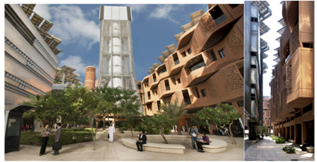
|
Figure 6 Masdar Wind
Towers are Contemporary Adaptations of Traditional Windcatchers, Engineered to
Naturally Cool Public Areas by Directing Breezes, Minimizing Energy Usage,
and Improving Comfort in the Arid Atmosphere of Masdar City |
The wind towers, or barjeel Figure 6, of Masdar City are a vital element of its sustainable urban design, integrating ancient cooling methods with contemporary engineering to improve the city's climatic resilience. These towers harness cooler air from higher heights and channel it to street level, facilitating natural ventilation in public areas and reducing the need for air conditioning. The wind turbines, strategically located in high-traffic zones, regulate pedestrian temperatures and thereby reduce the city's energy usage (Wagle, 2014). This passive cooling system illustrates Masdar's novel method of incorporating renewable energy concepts into urban design (Foster + Partners, 2019). Figure 7
Figure 7
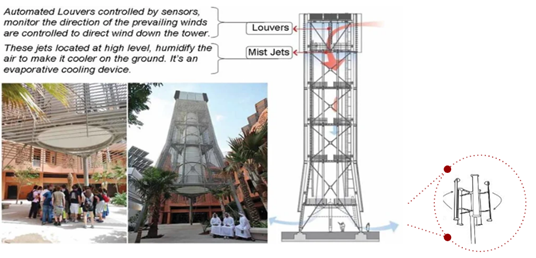
|
Figure 7 Masdar City Incorporates Automated Wind Towers Equipped with Adjustable Louvers to Optimize Airflow Based on Wind Direction and Velocity. the Towers' Upper Sections Feature Integrated Micro Wind Turbines, Generating Renewable Energy While Enhancing Natural Ventilation and Improving Overall Cooling Efficiency |
The strategic positioning of wind towers in urban areas, especially in zones with significant foot traffic, is essential for improving public spaces, particularly in dry climates such as Masdar City. Here is a comprehensive examination of the main elements you referenced:
7. Strategically Positioned in Communal Areas
By positioning wind towers in high-traffic areas—such as public plazas, pathways, and parks—urban planners may optimize the cooling benefits of these buildings where they are most essential. These sites often function as social and community centre’s, where people convene for recreation, food, and cultural pursuits. The cooling advantages of the wind tower are particularly obvious in these scenarios, since they not only improve comfort but also promote extended visits and heightened social engagement. The prominence and accessibility of the wind tower may enhance public understanding and appreciation of sustainable design methods.
7.1. Optimal Wind Acquisition
The design of wind towers is essential for their efficiency in harnessing colder air from higher heights. Conventional architecture designs often neglect to harness the cooler air present at elevated altitudes, resulting in suboptimal cooling in metropolitan environments. By adopting a higher design, wind towers may capture breezes that are generally more robust and colder than those at the surface. This function enables them to manipulate and guide wind downward, generating a revitalizing breeze at ground level. The design's performance may be improved by analysing local wind patterns to ensure the tower is appropriately oriented to harness prevailing winds, hence enhancing its overall efficiency.
7.2. Component of an Extensive Cooling Strategy
The incorporation of wind turbines into the overall architectural and urban architecture of Masdar City demonstrates a comprehensive commitment to sustainability. Wind towers function in combination with other passive cooling methods, like shaded pathways, green roofs, and energy-efficient building facades, rather than serving as independent solutions. This collaboration establishes a holistic cooling approach that reduces dependence on mechanical air conditioning and improves overall energy efficiency. Shaded areas may shield pedestrians from direct sunlight, while wind turbines provide airflow that enhances the cooling of these shaded places, making them more appealing.
7.3. Improving Microclimate
The installation of wind towers significantly enhances the microclimate of metropolitan environments. These structures mitigate ground temperatures, so fostering more pleasant outdoor conditions even during intense heat. This cooling impact might alleviate the urban heat island phenomenon, whereby metropolitan regions become markedly warmer than their rural counterparts owing to anthropogenic activity and infrastructure. The improved microclimate enhances public space comfort and fosters biodiversity by establishing more conducive circumstances for flora and fauna.
7.4. Proximity to Public Amenities
Locating wind turbines next to retail establishments, communal spaces, and transit centers guarantees that the advantages of improved airflow and cooling are realized in areas of high human activity. This strategic positioning may enhance foot traffic in commercial zones, helping local enterprises. Moreover, closeness to transportation hubs may enhance the comfort of waiting spaces, promoting the use of public transport instead of private automobiles, therefore supporting sustainable urban mobility objectives.
Energy Generated: The Masdar Wind Tower not only produces power but also functions as a passive cooling system aimed at enhancing outdoor thermal comfort.
7.5. Conserved Energy
A 20% to 50% decrease in cooling energy requirements for outdoor areas, achieved via natural ventilation and cooling methods, eliminating the need for air conditioning.
It reduces dependence on energy-consuming air conditioning equipment, hence enhancing overall energy efficiency in the outdoor public spaces of Masdar City.
The tower mitigates the urban heat island effect by passively chilling open areas, hence decreasing the cooling requirements of nearby structures.
Indirectly mitigates carbon emissions by decreasing power use for mechanical cooling systems.
Wind towers serve as an effective mechanism for improving urban settings, especially in arid regions. Their planned positioning in high-traffic public areas optimizes cooling advantages, enhances microclimates, and increases pedestrian comfort. When intelligently included into urban design, they enhance a sustainable and enjoyable public space that fosters social interaction and community involvement while reducing environmental impact. The experience of cities such as Masdar offers significant lessons for future urban development initiatives focused on sustainability and livability under adverse climatic circumstances.
8. Orientation and Layout of the Streets
Masdar City's urban design prioritizes the configuration of streets and structures to provide compact, shaded corridors that efficiently direct prevailing winds, thereby enhancing natural ventilation. This design technique is based on traditional Arabic architecture, which traditionally used narrow alleyways and wind towers to improve cooling via better ventilation Sahni et al. (2013). The strategic placement of structures not only offers shade but also facilitates the movement of cooler air from elevated areas to ground level, hence lowering outdoor ambient temperatures Abdel-Moaty et al. (2019). The natural cooling effect is especially significant in desert areas, where high temperatures may discourage outside activity. The architecture of Masdar City cultivates a more pleasant pedestrian environment, boosting public space engagement and supporting a healthier urban lifestyle Al-Masri et al. (2020). Masdar City exhibits a progressive approach to sustainable urban design by incorporating these concepts into its layout, prioritizing resident comfort and well-being while reducing energy use.
Figure 8

|
Figure 8 Masdar City Showcases a Variety of Urban Designs Suited for Various Types, Including Residential, Commercial, and Institutional Spaces, Each Crafted with Unique Layouts, Shading, and Ventilation Techniques to Maximize Energy Efficiency and Improve Environmental Outcomes |
Figure 9
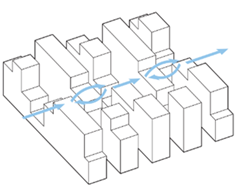
|
Figure 9 The Design of Masdar City's Buildings is Carefully Planned to Correspond with the Existing Wind Patterns, Promoting Natural Airflow and Decreasing Heat Absorption, Which Ultimately Boosts Energy Efficiency and Lessens Dependence on Mechanical Cooling Solutions |
In Masdar City, wind energy is integral to its design philosophy, serving as a primary renewable energy source that contributes to a remarkable 40% reduction in energy consumption compared to conventional standards Masdar (2021). This achievement is made possible through a combination of passive urban planning and innovative wind energy integration, which together enhance the overall efficiency of buildings and urban blocks. The city’s layout is strategically designed to maximize natural ventilation and harness local wind patterns, thereby reducing reliance on mechanical cooling systems Khalil & Zayed (2016). This approach not only decreases energy consumption but also promotes a healthier indoor environment by ensuring adequate airflow and reducing the urban heat island effect Ragab et al. (2020).
Figure 10
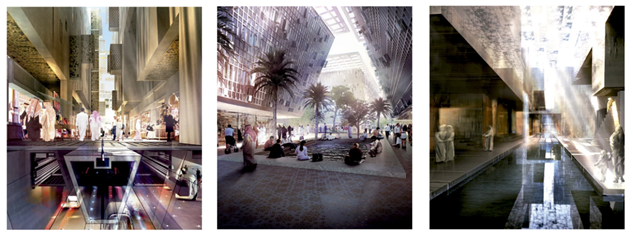
|
Figure 10 Shaded Courtyards and Walkways Within the Development Paints a Desert Idyll of Tranquility. Image Courtesy of Foster +Partners |
At the landscape level, wind energy is crucial in facilitating sustainable projects. Hydro-zones in the city utilize wind energy for irrigation, while 70% of native vegetation enhance water efficiency and promote biodiversity. These methods mitigate environmental damage and promote ecosystem resilience in dry settings Al-Weshahi et al. (2018).
9. Design of Buildings and Aerodynamics
The architectural design of Masdar City utilizes natural airflow for passive cooling, which is fundamental to its sustainability objectives. Structures possess aerodynamic facades that diminish wind resistance and optimize airflow, so significantly decreasing inside temperatures and minimizing dependence on artificial cooling systems Masdar (2023). The city's stratified design, with shorter edifices adjacent to the center wind tower and higher constructions at the periphery, reduces wind obstruction and improves air circulation. This design method enables the wind tower to sustain uniform airflow across the metropolitan area, optimizing cooling efficiency.
The strategic spacing between buildings optimizes airflow by mitigating turbulence caused by proximity and maintaining cooling efficiency by avoiding excessive gaps. The strategic placement of structures enhances passive cooling and substantially improves Masdar City’s energy efficiency, in accordance with its environmental objectives Alhammadi et al. (2022).
Masdar City utilizes tiered building elevations and wind catchment corridors to direct natural breezes into the urban center. These corridors channel airflow towards a central wind tower, enhancing air circulation in public places and maximizing natural ventilation in critical locations Smith & Patel (2021). Figure 11.
Figure 11
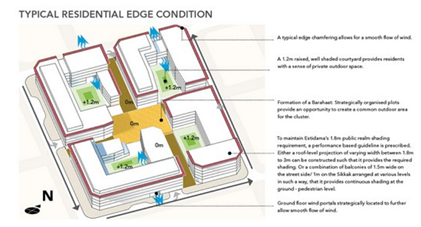
|
Figure 11 A Typical Building Design Strategically Optimizes its Shape and Layout to Harness, Enhance, and Channel Wind Effectively Toward Wind Towers, Maximizing Ventilation and Energy Efficiency Within the Urban Environment |
Figure 12
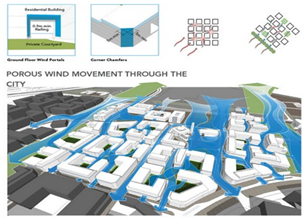
|
Figure 12 An Urban Plan and Infrastructure Design that Emphasizes Sustainability Through Climate-Responsive Strategies, Carefully Integrating Environmental Considerations. This Approach Ensures Efficient Resource Use, Enhances Resilience to Climate Impacts, and Promotes Long-Term Ecological Balance While Fostering Livable, Energy-Efficient, and Adaptive Urban Environments that Meet the Needs of Present and Future Generations |
The city's architecture has curving paths, an innovative element intended to facilitate ventilation. The meandering streets are not only decorative; they function to channel breezes from adjacent regions into the city's open areas and public squares. The design directs airflow through natural channels towards the wind tower, facilitating the circulation of cold air throughout the city and preventing the dissipation of wind energy Jones & Zhao (2020).
These features—stepped building heights, optimal spacing, wind catchment corridors, and curved pathways—form an urban environment that utilizes natural wind patterns to decrease reliance on artificial cooling, thereby reducing energy consumption and enhancing the city’s dedication to sustainability.
An aerodynamic facade design is essential for minimizing turbulence around buildings, facilitating a more uniform and steady wind flow across the structure. By reducing airflow disturbances, the building sustains a stable wind pattern, therefore diminishing pressure
Figure 13
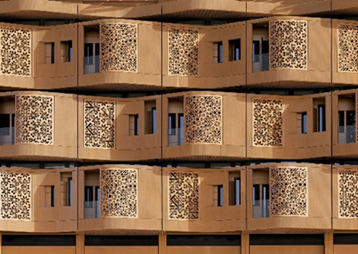
|
Figure 13 The Façade is Meticulously Designed to Respond to Wind Velocity and Direction, Incorporating Elements Such as Aerodynamic Shapes, Louvers, and Vents. These Features Optimize Airflow, Reduce Pressure Imbalances, Enhance Ventilation, and Improve the Building's Overall Energy Efficiency and Comfort |
variations and the formation of vortexes that can adversely affect energy efficiency and overall building performance. Moreover, streamlined surfaces improve natural ventilation by allowing the ingress of fresh air into the structure. This enhances circulation in interior environments, elevating air quality and diminishing reliance on mechanical cooling or ventilation, while concurrently decreasing wind load and minimizing structural stress on the edifice.
Urban Development Parameters
Figure 14
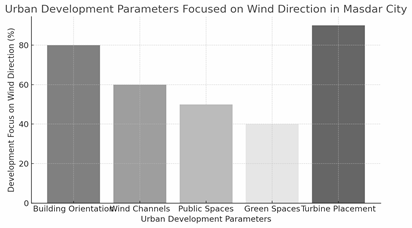
|
Figure 14 Masdar's Urban Development Emphasizes Wind Direction, Optimizing Street Layouts, Building Orientation, and Ventilation Corridors to Enhance Airflow and Cooling |
The architectural concepts of building orientation and wind channeling in Masdar City are essential for maximizing wind flow within the urban environment. Strategically positioning buildings to line with prevailing wind directions optimizes natural ventilation, facilitating the influx of cooler air into and across the structures. This design method reduces reliance on mechanical cooling systems while enhancing interior comfort, hence making rooms more appealing to inhabitants Ragab et al. (2020). The angular configuration of structures creates a network of routes that promotes circulation, averting the stagnation of hot air, which is essential in dry conditions.
Wind channels are integrated into urban planning to direct breezes throughout the city, so improving the efficacy of natural cooling. These channels are often created by the intentional arrangement of architectural shapes and materials that direct wind into communal areas, parks, and pathways. Narrower streets and open spaces may be engineered as wind corridors, efficiently channelling airflow to crowded regions and enhancing pedestrian comfort Khalil & Zayed (2016). This deliberate design strategy reduces the urban heat island effect, since cooler winds may lower elevated temperatures, enhancing outdoor conditions for both inhabitants and tourists.
The public spaces of Masdar City are intentionally oriented according to prevailing wind directions, so optimizing the advantages of natural breezes. Parks, plazas, and communal spaces are strategically located to optimize airflow, fostering pleasant microclimates conducive to relaxation, socialization, and community engagement. The incorporation of covered sitting areas and water features amplifies the cooling impact, hence improving the overall quality of life in these public spaces Al-Weshahi et al. (2018). By promoting social contact and community involvement, these well planned public areas serve as central hubs for the city.
The green spaces of Masdar City are purposefully positioned to improve airflow, mitigate heat, and promote biodiversity. They utilize indigenous vegetation to lower ambient temperatures via evapotranspiration, enhance air quality, and strengthen natural wind patterns, therefore integrating constructed and natural components Al-Masri et al. (2020).
The installation of wind turbines in Masdar City optimizes wind energy collection by situating them in regions with high wind potential, as determined by technical studies. This architectural decision guarantees efficient energy production while smoothly incorporating the turbines into the urban environment. This intentional configuration bolsters the city's dedication to renewable energy, diminishes dependence on fossil fuels, and promotes its sustainability objectives Masdar (2021).
Figure 15
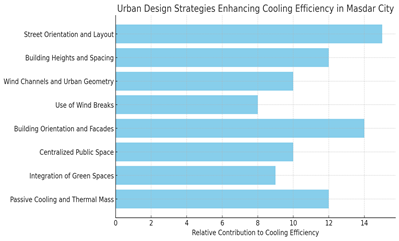
|
Figure 15 Masdar City Employs Urban Design Strategies Like Narrow Streets, Shaded Pathways, Wind Towers, and Optimal Building Orientation to Enhance Cooling Efficiency, Reduce Heat Gain, And Leverage Natural Ventilation for a More Sustainable Urban Environment |
10. Results
The study on the prospective implementation of wind integration technologies from Masdar City in GIFT City identifies numerous critical areas with differing degrees of viability. The investigation reveals that "Street Orientation & Layout" possesses the greatest feasibility at around 85%, since it may substantially affect wind flow patterns to improve natural ventilation in urban environments. "Building Facades & Shading" demonstrates a significant possibility of adoption, estimated at around 80%, indicating that shading and façade designs are crucial in mitigating heat gain and enhancing outdoor comfort.
Figure 16

|
Figure 16 The Left Image is of Masdar City, a Comparative Image of GIFT City Gandhinagar on the Left Which Could Lead by Masdar’s Example on Sustainable Development |
"Wind Channels & Geometry" and "Use of Wind Breaks" both offer viable solutions, each attaining over 70% feasibility, indicating the ability of strategically planned channels and barriers to successfully direct or regulate wind flow. Likewise, "Centralized Public Space" and "Integration of Green Spaces" each exhibit around 65% feasibility, suggesting that the incorporation of these architectural components can enhance wind flow management and cooling in public places.
"Building Heights & Spacing," with a feasibility of around 60%, may be considerably modified, since higher structures can affect wind circulation patterns at the pedestrian level. Ultimately, "Passive Cooling Techniques," while crucial for energy efficiency, exhibits the lowest practicality at around 50%, as it may necessitate substantial modifications to current building designs and materials.
The findings indicate that several wind integration solutions from Masdar City may be adapted to GIFT City's setting, offering a framework for improving urban sustainability and climate responsiveness in India's constructed surroundings.
Figure 17
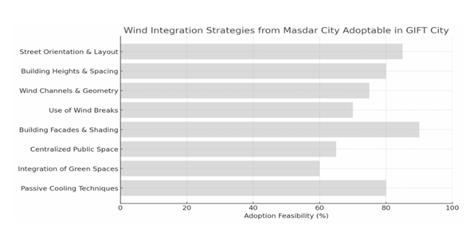
|
Figure 17 It Displays the Adoption Feasibility Percentage of Various Urban Design Strategies on a Scale From 0% to 100%. Each Bar Represents a Specific Strategy and its Corresponding Feasibility Percentage |
This study's findings indicate that both Masdar City and GIFT City exemplify smart city ideas centred on sustainability, with Masdar City acting as a paradigm for renewable energy integration, particularly wind energy. Although GIFT City is in its nascent phase and investigating renewable energy alternatives, Masdar's existing methodologies offer a significant basis for forthcoming wind energy strategies. Both communities seek to diminish carbon footprints via alternative energy sources, and Masdar's effective integration of wind energy offers a viable model for GIFT City to emulate. By employing analogous technologies, such as miniature wind turbines or hybrid systems, GIFT City may efficiently capture wind energy, especially during seasonal wind surges, to further its objectives for renewable energy integration and environmental sustainability.
11. Discussions
In Masdar City, architectural form significantly influences wind patterns. Structures are engineered to enhance natural ventilation by modifying local wind speed and airflow patterns. Architectural elements such as overhangs, canopies, and atriums improve airflow, provide cooler microclimates, and diminish dependence on mechanical cooling systems Ragab et al. (2020).
Wind energy and sustainability performance require an Integrated Design Approach. Architects, engineers, and environmental designers collaborate from the start to incorporate wind patterns, sun orientation, and energy efficiency. Masdar City has beautiful, eco-friendly designs Khalil & Zayed (2016).
Nonetheless, the division of design processes in contemporary architectural firms poses obstacles to attaining this integrated methodology. Frequently, architectural design and engineering study are executed as separate procedures, resulting in a disjunction between the architect's creative vision and the practical necessities of structural integrity and environmental performance. This division may lead to concessions that impede the building's overall efficiency and sustainability Al-Masri et al. (2020). Masdar City endeavours to close this gap by fostering collaborative design frameworks that promote multidisciplinary cooperation. Facilitating communication and integration between architectural design and engineering analysis enables projects to more effectively address environmental conditions and enhance performance, therefore advancing the city's sustainability objectives.
Masdar City and GIFT City's environmental quality depends on wind speed and urban form. Due to their open landscapes and airflow-focused urban development, both cities have moderate wind speeds. Wind speeds vary seasonally, with greater velocities in colder months for better natural ventilation and cooling and lower speeds in warm months. Seasonal wind patterns affect outdoor comfort and energy efficiency in buildings, therefore urban design should take these into account.
Masdar City exemplifies how aerodynamic architectural forms may improve ventilation and promote sustainable living by channelling cooler air throughout the city, hence diminishing reliance on mechanical cooling and fostering pleasant outdoor environments. GIFT City might implement these ideas to enhance cooling and circulation by utilizing wind corridors, green areas, and smart building orientation to provide a sustainable microclimate. Through insights gained from Masdar, GIFT may enhance urban design to promote natural ventilation, energy efficiency, and resistance against climate change.
12. Conclusions
Finally, Masdar City shows how sustainable urban design can incorporate renewable energy sources like wind and solar into its urban fabric. Similar measures may improve energy efficiency and sustainability in India, which is rapidly urbanizing and demanding more energy.
Policy ideas like renewable energy-focused urban planning may help urban wind energy growth. India may promote renewable energy infrastructure investment via subsidies, grants, and public-private partnerships, harmonizing with its Smart Cities aim. Economic development and robust, energy-efficient cities result from this connection.
Wind-responsive design and urban layout optimization may help India integrate its native wind resources. Decentralized energy sources, including tiny wind turbines, will stabilize the grid and meet urban energy demands. Decentralized storage technologies may also boost energy independence and minimize non-renewable energy use, making cities more sustainable.
The long-term advantages of Masdar City's approach are many. India can lead creative, eco-friendly urban development by improving urban energy sustainability. This tackles urgent
Figure 18
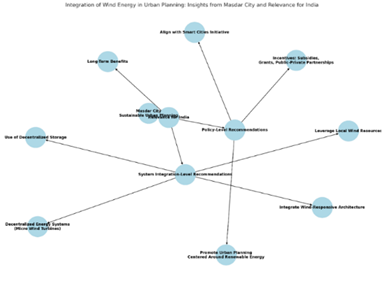
|
Figure 18 Here’s a Graphical Representation of the Integration of Wind Energy in Urban Planning, Highlighting the Insights from Masdar City and their Relevance for India. the Graph Outlines the Main Components, Including Policy-Level and System Integration Recommendations, Along with the Potential Long-Term Benefits. This Visual Can Help in Understanding the Interconnectedness of These Concepts and the Pathway Towards Enhancing Urban Energy Sustainability in India |
environmental and energy issues and prepares for sustainable, resilient, and citizen-centered development. Strategic planning and renewable energy may help India build successful cities that satisfy current and future needs, creating a better world for future generations.
13. Potential areas for further research
Future study on urban wind energy integration might reveal its long-term socio-economic effects. A complete study should include cost-benefit studies that examine wind energy systems' financial impacts and long-term economic viability. Such assessments would help city planners and officials assess large-scale wind energy project viability and make data-driven choices. Researchers may determine the economic sustainability of wind energy in urban areas by assessing installation costs, maintenance costs, energy savings, and surplus energy earnings.
Figure 19
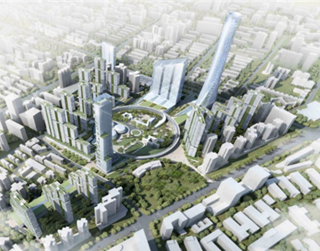
|
Figure 19 Futuristic Perspective of GIFT City. Source: GEDA. The City's Favorable Wind Speeds, Strategic Urban Planning, and Commitment to Sustainability Provide a Robust Foundation for Urban Wind Energy Projects. by Leveraging Technological Advancements and Learning from Global Examples, GIFT City Can Effectively Harness Wind Energy, Contributing to a Greener and More Energy-Efficient Future |
In addition to financial issues, further research should examine the practicality of operating wind energy systems in GIFT City and others. This study would assess these systems' real-world performance, including their wind energy efficiency and contribution to the urban energy mix. Wind energy projects need community buy-in, thus it's important to examine public opinion. Researching public opinion on wind energy infrastructure may assist identify impediments to acceptability and drive community involvement tactics.
Urban aesthetics and how wind energy systems affect city appearance should be another key study topic. Balancing energy demands with aesthetics requires understanding how wind turbines and other infrastructure affect metropolitan landscapes. This involves assessing design solutions that complement existing architecture and improve urban fabric, which may increase public support for wind energy programs.
Finally, analyse how wind energy installations affect local populations. Research should examine how these systems impact urban populations' livelihoods, well-being, and social dynamics. Understanding the socio-economic effects of wind energy integration can help cities create policies that encourage renewable energy, community development, and social equality.
In conclusion, urban wind energy integration study should incorporate economic analysis, practical efficacy, cultural acceptability, aesthetics, and community impact. Researchers may design sustainable urban energy plans that are economically feasible, socially acceptable, and useful to local populations by addressing these multidimensional characteristics.
CONFLICT OF INTERESTS
None.
ACKNOWLEDGMENTS
None.
REFERENCES
Al-Sallal, K. A., Al-Rais, L., & Bin Dalmouk, M. (2013). Designing a Wind Tower for Modern Urban Settings: A Case Study of Masdar City. Renewable Energy, 57, 24–34. https://doi.org/10.1016/j.renene.2013.01.016
Elgendy, K. (2011). The Wind Tower: Reviving a Traditional Cooling System in Masdar City. Sustainable Cities and Society, 1(1), 44–51. https://doi.org/10.1016/j.scs.2010.08.001
Fodell, S., & Al Jassmi, H. (2015). The Wind Tower in Masdar City: A Modern Adaptation of Traditional Architecture. In Proceedings of the International Conference on Sustainable Design and Construction (134–139). https://doi.org/10.1061/9780784413517.014
Masdar City. (2010). Innovative Architectural Solutions: The Wind Tower Project. Masdar Initiative.
Masdar. (2023). Masdar City: Sustainable Development in Action. Masdar Official Website.
Omer, A. M. (2008). Renewable Building Energy Systems and Passive Human Comfort Solutions. Renewable and Sustainable Energy Reviews, 12(6), 1562–1587.
Smith, J. (2022). Urban wind energy: Integrating
Renewables into the Urban Fabric. Renewable Energy Journal.
United Nations. (2021). World urbanization prospects. United Nations Department of Economic and Social Affairs.
|
|
 This work is licensed under a: Creative Commons Attribution 4.0 International License
This work is licensed under a: Creative Commons Attribution 4.0 International License
© ShodhShreejan 2025. All Rights Reserved.